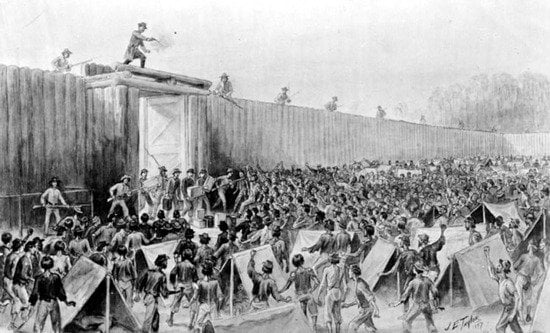POW Camps Final Stop For Many
Originally published in The Rock River Times

The Camp Sumter Military Prison at Andersonville, Georgia was of one of the biggest Confederate prisoners of war camps during the Civil War. It operated for 14 months and 45,000 Union prisoners passed through the gates even though the camp was designed for 10,000 men. Lack of food and clean water, no shelter from the elements and no medical care for the wounded left the men susceptible to disease. 13,000 of the men would die in the camp. 151 years have passed since the closing of the camp and today we know the horror stories of the survivors.
Horatio Foote’s family moved to Rockford the first time in 1838 and his father, Hiram, a Congregational Minister preached the first official sermon in town. The family moved to Wisconsin and it was in Racine in 1843 that Horatio was born. In 1862, Horatio enlisted in the 1st Wisconsin Cavalry Regiment Company B and went to Missouri for training.
The regiment would be involved in fierce fighting including the Battle of Chickamauga in September of 1863. In May of 1864, the men of the 1st Wisconsin were involved with the Battle of Varnell’s Station in Georgia. General Joseph Wheeler’s 900 Confederates fought against Brigadier General Edward McCook’s 5,000 Federals. Only 10 Confederate men lost their lives while 150 Federals were killed. Wheeler’s men also captured 100 Union soldiers that day and Horatio Foote was one of them.
Horatio and the other men were sent first to Andersonville and in September of 1864 they were moved to The Florence Stockade in Florence, South Carolina. During 1864, General Sherman was leaving a trail of devastation during the Atlanta Campaign and Camp Sumter (Andersonville) was right in the path. The decision was made to close the camp and scatter the prisoners to other existing camps. The Confederates also decided to build a new camp and chose Florence, South Carolina for the location because of the three railroads that traveled through the city.
Men were being moved into the Florence Stockade before it was even completed. The ones who were too ill to be moved from Andersonville were left behind. The men who were transferred were kept under control by the Confederates telling them that they had been paroled and would be allowed to return to their homes. One can only imagine the heartbreaking moment when these soldiers who had suffered so much at Andersonville discovered the truth about their destination.
The Florence Stockade was designed like Andersonville with a creek running through the middle and a trench all around the outside to prevent the men captured from digging escape tunnels. Confederate Major Frederick Warley supervised the 1,000 prisoners of war were used to construct the camp. The 1,400 foot long rectangle was enclosed with a timber fence. There was a “deadline” 10 feet from the fence that the guards were told to shoot anyone who passed that line.
The prison opened in September of 1864 and within a month 12,000 men were imprisoned there. Supplies were so scarce that even the Confederate guards didn’t have enough to eat. Disease was widespread. The death rate was 20-30 men per day. One Union soldier who survived both, John McElroy, wrote, “I think also that all who experienced confinement in the two places are united in pronouncing Florence to be, on the whole, much the worse place and more fatal to life.” Part of the reason that Florence proved so deadly was the weakened state that the prisoners arrived in from their time in Andersonville.
The camp closed in February of 1865. Horatio did not survive the camp and his body, like many others, was buried in a mass grave with no real identification possible. The area is now a national cemetery. Horatio’s family wanted him to be remembered and listed his information on a memorial marker with his other family members at Cedar Bluff Cemetery.
Copyright © 2015 Kathi Kresol, Haunted Rockford Events
